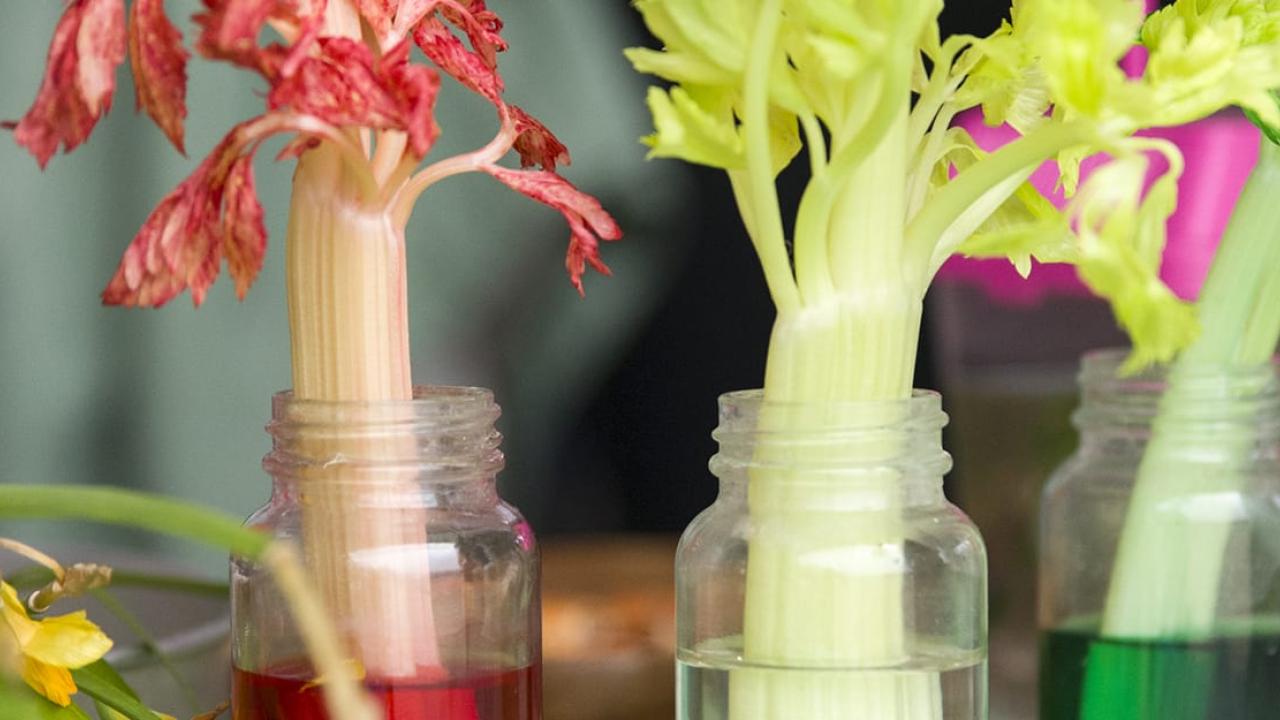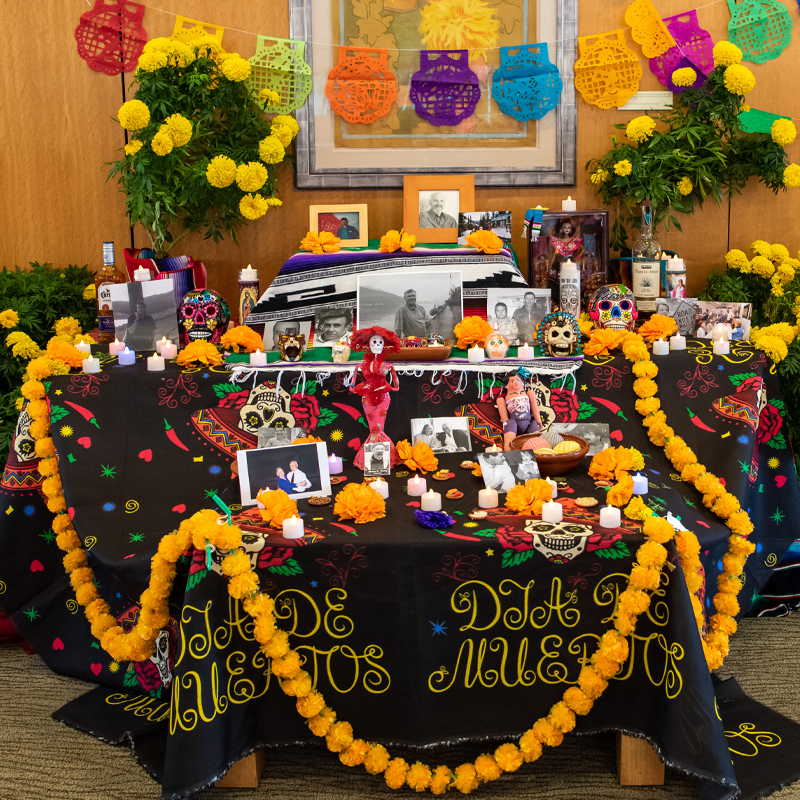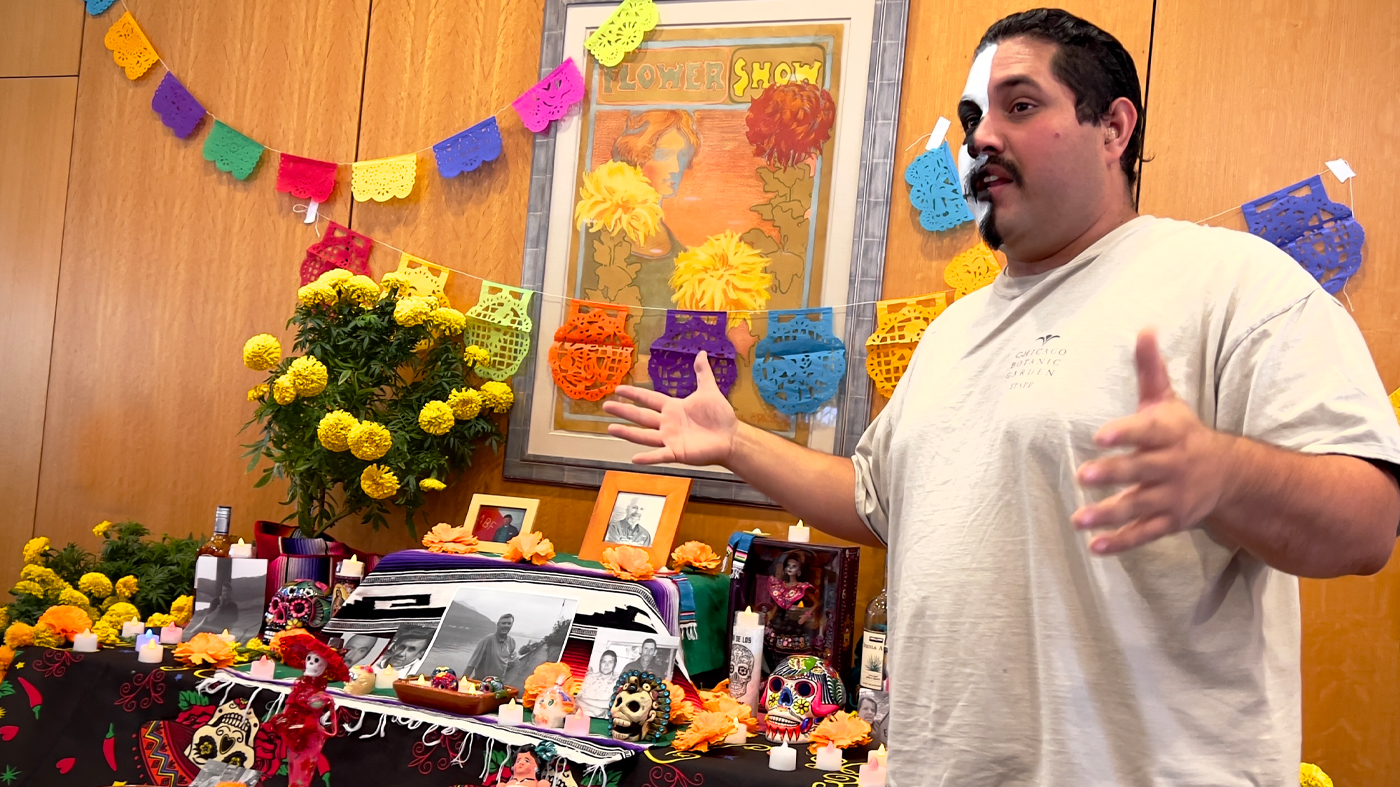

Learning
Garden Stories
Celebrating Día de los Muertos
 We built this ofrenda for staff at the Chicago Botanic Garden last year.
We built this ofrenda for staff at the Chicago Botanic Garden last year.
Our family only leaves us when we forget about them
With an armful of fragrant marigolds, I headed toward the laughter coming from my family’s graves.
That year, in Mexico for Día de los Muertos, I was a 16-year-old kid from Chicago who was just beginning to understand what the holiday meant.
The Day of the Dead brings us closer to our ancestors through stories—like the ones I heard about my great grandfather when he was a boy. In the middle of the night, he would swim across a river to see the girl who would later become my great grandmother. And he got into all sorts of other shenanigans.
Now, as a horticulturist, I teach a class on Day of the Dead flowers and traditions at the Chicago Botanic Garden. Here’s what I tell the participants: Our family only leaves us when we forget about them.
On Día de los Muertos, November 1 and 2, my family invites the spirits of our ancestors back with offerings, things that they loved—for my great grandmother, yellow roses and mole de espinazo (made with verdolagas, or purslane); for my great grandfather, a traditional cold drink called tejuino; for everyone, tamales rojos and tequila, along with mariachi bands who play songs late into the night.
My great grandfather was a rancher, who raised pigs. Just knowing that he drank tejuino—made of fermented corn masa—every day made me feel like I had a shared bond with him. I love tejuino, too, and would drink it every day if I could.
As a teenager, on that visit to Jalisco, in a town near Guadalajara, I was struck by the happy feeling at my family’s graves. More than 20 relatives, who had been cleaning the tombstones and mausoleums, stood in a circle—aunts, uncles, cousins, my parents and siblings from Chicago. Some of them had tears in their eyes—from laughter. That’s when I realized that there’s no reason to be sad, that our ancestors are still with us in spirit.
Who knows, maybe someday, I’ll be like my grandfather. At age 89 or 90, he would ride a bike six miles to visit his pigs. He’s the type who would slip a shot of tequila in your coffee when you’re not looking….
Those are the kinds of things I think about on Día de los Muertos. It’s about spending time with my ancestors, remembering who they are and my connections to them. I’m continuing on the path that they started on; I am their future.
What is Día de los Muertos?
Día de los Muertos dates back 3,000 years to the Aztecs and Olmecs. They would honor the deceased with a festival dedicated to the goddess Mictecacihuatl, who watches over the dead. This festival emphasized that death is a cyclical part of the universe and need not be feared; the “veil” between life and death is the thinnest on this holiday, allowing the deceased to “visit” their family ofrendas.
This festival was celebrated in the ninth month of the Aztec solar calendar, which corresponds to the modern months of July and August. When Catholicism was introduced with the Spaniards, the celebration was moved to coincide with the fall harvest, along with All Saints’ Day and All Souls’ Day on November 1 and 2.
These days, the holiday has grown even bigger. Día de los Muertos, which once was mostly celebrated in Mexico and Central America, has expanded around the world. There are only four other countries that have their own celebration around remembering deceased loved ones. Those countries are China, India, Japan, and Cambodia.
 Last year, at our staff’s Día de los Muertos celebration, I talked about the holiday traditions. Half of my face is painted to resemble a skull, in honor and remembrance of the dead.
Last year, at our staff’s Día de los Muertos celebration, I talked about the holiday traditions. Half of my face is painted to resemble a skull, in honor and remembrance of the dead.
Carlos A. Barajas is a horticulturist at the Chicago Botanic Garden.
What is an ofrenda?
Just like my ancestors did, we build ofrendas, or altars, to allow our ancestors to join us as we engage in the time-honored tradition of sharing stories of our family.
The ofrendas, poignant expressions of love and connection, are the heart of Día de los Muertos. We make offerings to bridge the gap between worlds, inviting spirits to share cherished memories and the warmth of the family.
For my family, building the ofrenda is an important and cherished tradition. As we carefully arrange the elements upon the altar—candles, blossoms, fragrant incense, refreshing water, and more—a sense of eager anticipation fills the air, for we are keenly aware that before long, the spirits of our beloved grandparents and my dog will grace us with their return.
Every element on the altar holds a profound purpose and significance, particularly the blooms. We choose the flowers for their cultural and symbolic significance in Mexican traditions. These might include gladiolus, symbolizing loyalty; baby’s breath for the children; and Mexican marigolds or cempasúchil.
Marigolds are bright and vibrant like the sun, a symbol of life, warmth, and energy in Mexican culture. The Aztecs used cempasúchil, or marigolds, as offerings to the goddess of the underworld and dead, Mictecacihuatl. To this day, cempasúchil is thought to guide spirits of loved ones to their family altars and grave sites.
The final addition to the altar is the assortment of foods that our grandparents enjoyed. It is always difficult to choose because our grandparents had so many favorite dishes. So every year, we set out a different favorite dish for them.
While we assemble the altar, there are moments when a sense of longing and sadness may wash over us. Yet, we find solace in the understanding that, though our ancestors are no longer here in person, their love and memories continue to reside within us.
Celebrando el Día de los Muertos
 Construimos esta ofrenda para el personal del Jardín Botánico de Chicago el año pasado.
Construimos esta ofrenda para el personal del Jardín Botánico de Chicago el año pasado.
Nuestra familia sólo nos deja cuando nos olvidamos de ellos
Con un puñado de fragantes Cempasúchil, me dirigí hacia las risas que surgían de las tumbas de mi familia.
Ese año, en México para el Día de los Muertos, yo era un chico de Chicago de 16 años que apenas comenzaba a comprender lo que significaba la festividad.
El Día de Muertos nos acerca a nuestros antepasados a través de historias, como las que escuché sobre mi bisabuelo cuando era niño. En medio de la noche, cruzaba un río nadando para ver a la niña que más tarde se convertiría en mi bisabuela. Y se metió en todo tipo de travesuras.
Ahora, como horticultor, doy una clase sobre las flores y las tradiciones del Día de Muertos en el Jardín Botánico de Chicago. Esto es lo que les digo a los participantes: Nuestra familia sólo nos deja cuando nos olvidamos de ellos.
En el Día de los Muertos, el 1 y 2 de noviembre, mi familia invita a los espíritus de nuestros antepasados a regresar con ofrendas, cosas que les encantaban: para mi bisabuela, rosas amarillas y mole de espinazo (hecho con verdolagas) para mi bisabuelo, una bebida fría tradicional llamada tejuino; para todos, tamales rojos y tequila, junto con bandas de mariachis que tocan canciones hasta altas horas de la noche.
Mi bisabuelo era ganadero y criaba cerdos. El solo hecho de saber que bebía tejuino (hecho de masa de maíz fermentada) todos los días me hizo sentir que compartía un vínculo con él. A mí también me encanta el tejuino y, si pudiera, lo bebería todos los días.
Siendo adolescente, en aquella visita a Jalisco, en un pueblo cercano a Guadalajara, me impactó el sentimiento de alegría ante las tumbas de mis familiares. Más de 20 familiares, que habían estado limpiando las lápidas y los mausoleos, formaban un círculo: tías, tíos, primos, mis padres y hermanos de Chicago. Algunos de ellos tenían lágrimas en los ojos por la risa. Fue entonces cuando me di cuenta de que no hay razón para estar triste, que nuestros antepasados siguen con nosotros en espíritu.
Quién sabe, tal vez algún día sea como mi abuelo. A los 89 o 90 años, andaba en bicicleta seis millas para visitar a sus cerdos. Él es del tipo que pondría un trago de tequila en tu café cuando no estás mirando….
Ese es el tipo de cosas en las que pienso en el Día de los Muertos. Se trata de pasar tiempo con mis antepasados, recordar quiénes son y mis conexiones con ellos. Sigo por el camino que ellos iniciaron; Yo soy su futuro.
¿Qué es el Día de los Muertos?
El Día de los Muertos tienen su origen mas de 3.000 años atras entre los aztecas y los olmecas. Honrarían a los difuntos con una fiesta dedicada a la diosa Mictecacihuatl, quien vela por los muertos. Este festival enfatizó que la muerte es una parte cíclica del universo y no hay que temerla; El “velo” entre la vida y la muerte es más fino en esta festividad, lo que permite al difunto “visitar” sus ofrendas familiares.
Este festival se celebraba en el noveno mes del calendario solar azteca, que corresponde a los meses modernos de julio y agosto. Cuando se introdujo el catolicismo entre los españoles, la celebración se trasladó para que coincidiera con la cosecha de otoño, junto con el Día de Todos los Santos y el Día de Todos los Difuntos el 1 y 2 de noviembre.
En estos días, el festival se han hecho aún más grandes. El Día de los Muertos, que alguna vez se celebró principalmente en México y Centroamérica, se ha expandido por todo el mundo. Sólo hay otros cuatro países que tienen su propia celebración en torno a recordar a los seres queridos fallecidos. Esos países son China, India, Japón y Camboya.
 El año pasado, el Jardin celebro el Día de los Muertos, y hablé sobre las tradiciones y la ofrenda. La mitad de mi cara está pintada para que parezca una calavera, en honor y recuerdo de los muertos.
El año pasado, el Jardin celebro el Día de los Muertos, y hablé sobre las tradiciones y la ofrenda. La mitad de mi cara está pintada para que parezca una calavera, en honor y recuerdo de los muertos.
Carlos A. Barajas es horticultor del Jardín Botánico de Chicago.
¿Qué es una ofrenda?
Al igual que lo hicieron mis antepasados, construimos ofrendas o altares para permitir que nuestros antepasados se unan a nosotros mientras participamos en la tradición consagrada de compartir historias de nuestra familia.
Las ofrendas, conmovedoras expresiones de amor y conexión, son el corazón del Día de los Muertos. Hacemos ofrendas para cerrar la brecha entre mundos, invitando a los espíritus a compartir recuerdos preciados y la calidez de la familia.
Para mi familia, construir la ofrenda es una tradición importante y apreciada. Mientras colocamos cuidadosamente los elementos sobre el altar (velas, flores, incienso fragante, agua refrescante y más), una sensación de ansiosa anticipación llena el aire, porque somos muy conscientes de que, en poco tiempo, los espíritus de nuestros queridos abuelos y de mi perro nos honrarán con su regreso.
Cada elemento del altar tiene un propósito y un significado profundos, particularmente las flores. Elegimos las flores por su significado cultural y simbólico en las tradiciones mexicanas. Estos podrían incluir gladiolos, que simbolizan la lealtad; aliento de bebé para los niños; y caléndulas mexicanas o cempasúchil.
Las Cempasúchil son brillantes y vibrantes como el sol, un símbolo de vida, calidez y energía en la cultura mexicana. Los aztecas utilizaban cempasúchil, o caléndulas, como ofrenda a la diosa del inframundo y de los muertos, Mictecacihuatl. Hasta el día de hoy, se cree que el cempasúchil guía a los espíritus de los seres queridos a sus altares familiares y tumbas.
La última adición al altar es la variedad de comidas que disfrutaban nuestros abuelos. Siempre es difícil elegir porque nuestros abuelos tenían muchísimos platos favoritos. Por eso, cada año les proponemos un plato favorito diferente.
Mientras montamos el altar, hay momentos en los que una sensación de anhelo y tristeza puede invadirnos. Sin embargo, encontramos consuelo al comprender que, aunque nuestros antepasados ya no están aquí en persona, su amor y sus recuerdos continúan residiendo dentro de nosotros.

